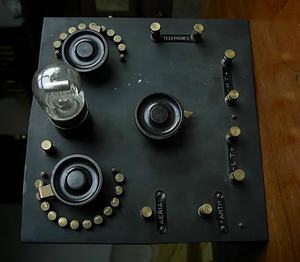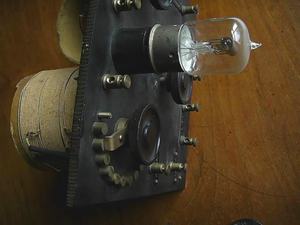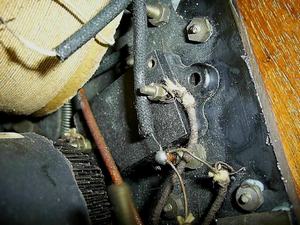The Reflex circuit or dual amplification was invented by the German, Schoemilch, in 1913, although in the USA, Frank Squire and William Priess (the self proclaimed ‘father of reflex’), developed the Lee de Forest D10 4 valve reflex receiver in the 1920’s as mentioned in Alan Douglas’s book , “Radio Manufacturers of the 1920s, Vol. 1. “Vestal, New York: Vestal Press, Ltd., 1988
The best example of a reflex receiver known to collectors is, of course, the Marconiphone V2 receiver. Unlike earlier examples of reflex receivers which used a crystal for detection, the V2 uses a valve.
Because of the high cost of valves in the 1920’s reflex design was attractive, as one valve was made to do the job of two, both as the RF and LF amplifier.



The wireless shown below was listed on eBay and little interest was shown in it as it is home constructed. But on seeing the very old design and especially the old iron wire core transformer construction, I decided to buy it as this pointed to a reflex one valve circuit. So it turned out to be. The constructor, not having room for the crystal detector, made this external with terminals for the connections.
History repeats itself, for when the first transistors radios came on to the market in the 1950’s the first transistors were, like the 1920’s valves, rather expensive. This enabled the reflex design to be used once again in order to save the cost of transistors.
The basic circuit of a transistor reflex is shown here, and the designer, Sir Douglas Hall, had spent most of his life in the

Colonial Service, then a magistrate in Devon, and so returned to his schoolboy interest, the designing of radios. He had a series of such articles in the ‘Radio Constructor’ from 1962-1980.
“The ingenious circuits of Sir Douglas Hall.”
This is the one valve reflex receiver found on eBay. All the tuning is by tapped coils brought out to stud switches.
The small RF bypass condenser is shown on the right here, and below that the LF transformer.
The circuit diagram can be seen here, together with more history of the reflex circuit and how it works.